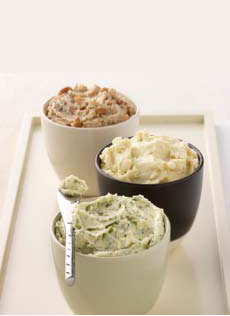TIP OF THE DAY: Make Hazelnut Butter
|
|
Here’s a treat from Chef Johnny Gnall: hazelnut butter—the compound butter, not the peanut butter spread alternative. He learned it a while back while working at Aziza restaurant in San Francisco, and is “still finding new uses for it every day.”
“For some reason, the hazelnut seems to sit in a class of its own, a bit more indulgent than pecans, walnuts, almonds and other nuts,” says Chef Johnny. “Hazelnuts work beautifully in sweet recipes and savory ones alike. Their richness and unique flavor can exist in the background of a dish, or they can be the star, paired with nothing more than a bit of chocolate. “They also hold some hidden potential: hazelnut butter! Almost any nut can be made into a compound butter, but hazelnuts have an unmistakable richness and a hint of sweetness that is just perfect for everyday or special occasions.” |
|
|
COMPOUND BUTTER RECIPE Ingredients 1. Combine. Add hazelnuts and milk to a sauce pan. Milk should completely cover the hazelnuts, plus a little more to accommodate evaporation. You can always add more milk if the level drops. 2. Boil. Bring to a boil, then reduce to a simmer. Cook for at least thirty minutes, and up to an hour. When you take the pan off the heat, the hazelnuts should be soft to the touch, but not so soft that they break down completely. Strain the milk out and reserve it. 3. Purée. Add hazelnuts to a blender with half a cup of the milk and purée until smooth. If needed, add milk, a bit at a time, to facilitate the puréeing. But do so cautiously, as too much milk will leave you with hazelnut soup instead of hazelnut butter. 4. Season. Once you have a smooth, thick, puréee, use a spatula to get it into a large bowl. Season with a pinch of salt and some maple syrup. The goal of the syrup is to add just enough sweetness that it brings out the natural sweetness of the hazelnuts. Add it a tablespoon at a time, incorporating well with a whisk and tasting afterwards. The whole batch shouldn’t take more than a few tablespoons of maple syrup. 5. Strain. Finally, you have the option to strain the hazelnut butter through a chinoise. This step is only necessary if you are are going for that impeccable, restaurant-quality texture. Otherwise, the hazelnut butter is quite smooth and delicious even without straining. Also note that if you used unpeeled hazelnuts, you may prefer to strain out the skins. 6. Cool. At this point, the butter is in a soft state. Let it stand for an hour in a cool place, covered, so the flavors can develop; then refrigerate to harden. HOW TO STORE HAZELNUT BUTTTER There are three basic different ways to store the butter: You also can freeze the butter for a month or more. HOW TO USE HAZELNUT BUTTTER More compound butter recipes.
|
||



